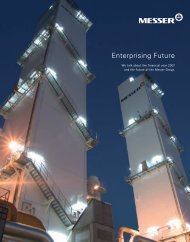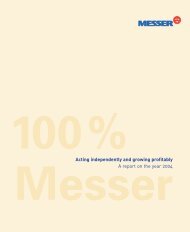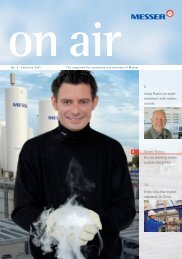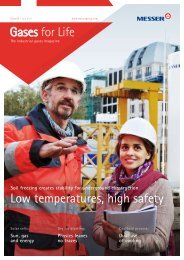Gases for Life - Messer Group
Gases for Life - Messer Group
Gases for Life - Messer Group
You also want an ePaper? Increase the reach of your titles
YUMPU automatically turns print PDFs into web optimized ePapers that Google loves.
<strong>Gases</strong> make beverages sparkle and keep them fresh <strong>for</strong> longerPleasant, invigorating andextremely usefulActually, nature intended the nose and lungs <strong>for</strong> the physical absorption of gases. But evenin the ancient world, people enjoyed the experience of drinking mineral water in which tinybubbles would rise up and cause a tingling sensation on the tongue. And when it came tobeer, people not only enjoyed its alcohol content, they liked its frothiness too. The tinglingand frothiness were caused by the carbon dioxide which ended up in these beverages as aresult of natural processes and without human intervention. The past century saw the startof the global success of sparkling beverages that contain additional CO 2 . Today, gases play anincreasingly important role in the processing and filling of beverages.Image: Krones AGMan’s first and – until the 18thcentury – only encounter withsparkling mineral water was at mineralsprings with a natural CO 2 content.These springs are usually found in areasthat experienced a lot of volcanic activityin the past. As the magma cools, itreleases carbon dioxide, which dissolvesin the natural mineral water. This is whathappened in Selters an der Lahn, a smallplace in Hesse, where a world-famousmineral water is bottled. “Selters” – andthe Anglo-Saxon variant “Seltzer” – hasthus become internationally synonymouswith sparkling mineral water. Naturalmineral water or soft drinks can be enrichedwith naturally sourced or processsourcedcarbon dioxide. This was firstdone in 1772 with CO 2 that escapesduring beer fermentation. Getting carbondioxide into a liquid is not difficult inprinciple. CO 2 dissolves so well in waterthat you can do it by merely blowingthrough a straw, at least <strong>for</strong> a smallamount. The colder the liquid and thehigher the pressure, the better the gasdissolves, however. Cooling and positivepressure are there<strong>for</strong>e used in theproduction of carbonated beverages. Inmany cases, the gas is only added to theliquid at the bottling stage. If beveragemanufacturers do not have access toCO 2 of their own, they usually get it fromcarbon dioxide plants or gas supplierssuch as <strong>Messer</strong>. Naturally, the beverageindustry’s peak CO 2 demand is in thesummertime.Continued on page 12Carbon dioxide is frequently used whenbottling drinks.10 <strong>Gases</strong> <strong>for</strong> <strong>Life</strong> 03 | 2011










